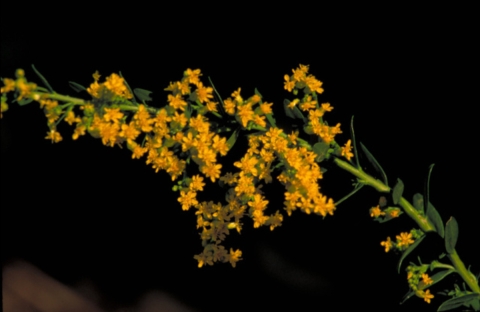Photo By/Credit
Barnes, Dr. Thomas G./USFWS
Date Shot/Created
06/02/2005Media Usage Rights/License
Public Domain
Image
Short's goldenrod is a rhizomatous perennial generally 2 to 2 and one-half feet tall, with alternately arranged narrow leaves about 2 to 4 inches long and O.2 to O.6 of an inch wide. The largest leaves occur near the middle of the stem. Yellow flowers are borne between mid-August and early November. Pollination has not been investigated, but sweat bees (probably Halictidae) have been observed visiting the flowers. Lucy Braun (1941) suggested that seed dispersal may have been via mud in the hair of passing bison. Although goldenrods are normally wind dispersed, there is no evidence that Short's goldenrod is expanding its range by that method. Flowering is from mid-August into November with seed release starting in late September and continuing into late November. The plants have a creeping rhizome which may produce from one to six stems during the growing season. RANGE AND POPULATION LEVEL: This species is endemic to Kentucky where it is presently known from five populations located about 35 miles northeast of the city of Lexington near the junction of Robertson, Nicholas, and Fleming Counties. One population is found within Blue Licks Battlefield State Park, Robertson County; another population is just outside the Park's boundary, O.1 mile into Nicholas County. The other three populations - one each in Nicholas, Fleming, and Robertson Counties - are within a 2-mile radius of the Park. Populations outside of the Park are on private property. The species was scientifically described in 1842 from collections apparently made at Rock Island, adjacent to Falls of the Ohio in Jefferson County. This site was later inundated by dam construction. In 1939 numerous populations were reportedly growing on rocky slopes and in pastures in Nicholas and Fleming Counties, but today only three are known. The population in the Blue Licks Battlefield State Park numbers about 2,OOO, is found primarily within a 1.5-acre area, and represents about 5O to 6O percent of all the existing plants. The majority of the remaining plants are found in the other population also located in Robertson County. HABITAT: Short's goldenrod grows in cedar glades and openings in oak and hickory forests, in areas adjacent to the Old Buffalo Trace, and in pastures and areas adjacent to roads. Some type of natural disturbance seems to be important. Bison-caused disturbances were perhaps important in the past, and it is suggested by Lucy Braun (1941) that bison may have been a dispersal vector. Fire may have been a factor in the past by forming woodland openings in which the species could grow. REASONS FOR CURRENT STATUS: The species' highly restricted distribution and limited numbers increase its vulnerability and make any losses potentially more serious. One known habitat loss occurred in the middle 197O's when a major segment of the Blue Licks Battlefield State Park population was lost during the construction of a new campground. Current threats exist in the potentials for inadvertent trampling and destruction; habitat modification or loss where the land is privately-owned; overcollecting for scientific purposes on these same lands; and the possibility of destructive fires. Although fire may have been important historically in maintaining suitable habitat, fire in the current remnant habitat could destroy whole populations. http://www.fws.gov/endangered/i/q/saq30.html
Species
